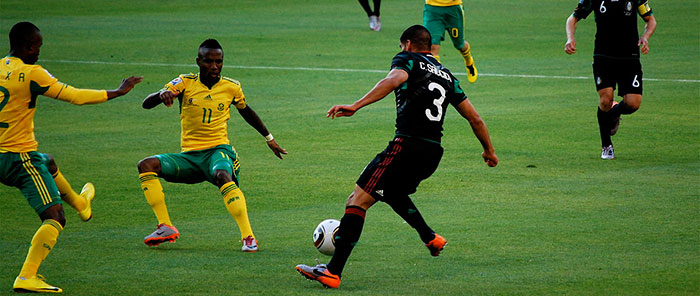World Cup Players Hope To Beat The Heat

Image rights: First Match of the FIFA World Cup - Mexico VS South Africa - In Soccer City, Johannesburg
Simo82 via flickr | http://bit.ly/1hMDtmF
http://bit.ly/cGotEb
(Inside Science) – Soccer's quadrennial World Cup is scheduled to start on time this week in Brazil, despite delays in creating the necessary infrastructure, strikes, charges of corruption, and deaths of workers in new stadiums. But one problem remains: climate conditions that will sap the strength and vitality – and possibly damage the health – of the elite players who represent the 32 nations in the tournament.
That's ironic, because the event is taking place in the southern winter – the natural season for the game. But for several international teams, the tourney will represent a winter of discontent.
Stadiums in northern Brazil will host the most extreme weather. Daytime temperatures in some locations will exceed 85 degrees Fahrenheit, and humidity will exceed 75 percent. The conditions will make it difficult for teams to exert maximum effort over the entire match, especially teams from cooler climes.
"In humid conditions, moisture in the atmosphere prevents the evaporation of sweat, which drips instead, a less efficient heat loss mechanism," explained John Brewer, a former head of sport science for the English Football Association and currently a professor of sport at the U.K.'s University of Bedfordshire. "High environmental temperatures also reduce the body's ability to radiate heat into the atmosphere, so both heat loss mechanisms are compromised."
In the effort to cool down, the body produces more sweat. A 165-pound player could lose more than a third of a gallon of water after one 45-minute half, representing about two pounds of his weight, Brewer said. Sweating also causes the loss of electrolytes such as sodium, which can compromise the function of the nerves and muscles.
In humid conditions, the body also diverts blood to the skin. That, "places an additional demand on the heart," Brewer said. "So the heart rate has to increase, causing fatigue."
The overall result: Players' work rates will fall, and their concentration and skill levels will probably decline.
That decline becomes significantly more pronounced at the end of matches played in the heat, according to Julien Périard and Sébastien Racinais, research scientists at Aspetar, a sports medicine hospital in Qatar.
That could lead to exciting finishes, but less than superior soccer in some games.
So serious is the climate issue that the Brazilian player's union sued the Fédération Internationale de Football Association (FIFA), which organizes the World Cup. The union called on FIFA to change the 1 p.m. kick-off times of games in the hottest, most humid locations during which, the union claimed, players' health would be most at risk.
The lawsuit also called on FIFA to introduce two-minute breaks during each 45-minute half of games for players to drink water or other fluids, an approach used during matches at the 2008 Olympic Games in sultry Beijing.
In response, FIFA asserted that it had already changed seven kick-off times, and had avoided 1 p.m. kick-offs in Manaus, Cuiaba, and Fortaleza, the three hottest locations, and that a FIFA medical officer will evaluate playing conditions before each match.
"FIFA's medical team is always monitoring carefully all venues during any FIFA competition to protect the players' health," the organization's statement noted. "Cooling breaks will be considered on a match-by-match basis for the 64 matches."
Meanwhile, medical staffs supporting the World Cup teams have devised their own techniques for beating the heat and humidity.
"There's lots of little things you can do that on their own wouldn't made a fundamental difference, but they all add up," said Michael Tipton, the director of research for sport and exercise science at the U.K.'s University of Portsmouth.
The process starts well before the tournament. Périard recommends checking individual players for susceptibility to heat and humidity and leaving the more vulnerable off team rosters or using them only as substitutes in the hottest locations.
Closer to the event, sports medicine specialists call for a 10 to 14 day period of acclimatization to the conditions. "Players will experience an increase in [blood] plasma volume, which will reduce their heart rate, and find that they are better able to tolerate the conditions," Brewer explained.
Thus the Australian team landed in Brazil on May 31, 13 days before their first match against Chile. And later arriving teams acclimatized in their own ways. Italian players trained on treadmills and stationary bikes in a sauna at 90 degrees Fahrenheit and 70 percent humidity. And English players wore three layers of clothing at their training camp in Portugal.
Staying hydrated before and during games is equally important. "Scientists have shown that drinking carbohydrate-electrolyte solutions is the most effective way of replacing fluid and electrolytes, as well as replacing energy stores that could become depleted towards the end of a game or during extra time," Brewer said. "Using equipment such as ice vests at half time to lower core temperature, and with the substitutes, is also a good idea."
Coaches must also be prepared to alter their strategies in the heat, instructing their teams to play at lower tempos, particularly early in games. Indeed, the sweltering conditions seem likely to give a key advantage to teams used to playing at a leisurely pace.
Whether that strategic factor plays out remains to be seen. But there's no doubt that the eventual World Cup winner will have successfully outlasted heat and humidity, as well as 31 opposing teams.

